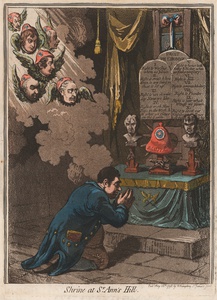| Method | Etching and aquatint with original hand colouring |
| Artist | James Gillray |
| Published | Pubd. May 26th 1798 by H. Humphrey, St James Street |
| Dimensions | Image 355 x 258 mm, 360 x 260 mm, Sheet 410 x 292 mm |
| Notes |
A satirical attack on Whiggish motivation, issued during Charles James Fox's secession from Parliament after the overwhelming support given to Prime Minister William Pitt in favour of war with France. The scene is set in Fox's wife's house on St Ann's Hill. He crouches in devotion, hands joined in prayer, before an altar of French 'idols.' The altar cloth is decorated with a crossed daggers motif, and in place of the crucifix is a cockaded liberty cap above a skull and crossed bones, below which is the motto 'Exit Homo' - Man's exit - a parody of 'Ecce Homo.' On either side of the phrygian cap are busts, to the left 'Robert Speire' - Robespierre, and to the right 'Buona-parte.' Above these, suspended from a bloodied and beribboned guillotine, are a pair of tablets made to resemble the Ten Commandments, but instead bearing the 'Droit de l'Homme.' The full list is inscribed as follows: 'I. Right to Worship whom we please. II. Right to create & bow down to any thing we chuse to set up. III. Right to use in vain any Name we like. IV. Right to work Nine Days in the Week, & do what we please on the Tenth. V. Right to honor both Father & Mother, when we find it necessary. VI. Right to Kill. VII. Right to commit Adultery. VIII. Right to Plunder. IX. Right to bear what Witness we please. X. Right to covet our Neighbour's House & all that is his.' From a window to the left of the altar, a stream of heavenly light and cloud brings forth six cherubim, their winged faces representing Norfolk, Lansdowne, Bedford, Tierney, Lauderdale, and Nicholls. James Gillray (c.1756-1815), was a British caricaturist and printmaker famous for his etched political and social satires. Born in Chelsea, Gillray studied letter-engraving, and was later admitted to the Royal Academy where he was influenced by the work of Hogarth. His caricature L'Assemblée Nationale (1804) gained huge notoriety when the Prince of Wales paid a large sum of money to have it suppressed and its plate destroyed. Gillray lived with his publisher and print-seller Miss (often called Mrs) Humphrey during the entire period of his fame. Twopenny Whist, a depiction of four individuals playing cards, is widely believed to feature Miss Humphrey as an ageing lady with eyeglasses and a bonnet. One of Gillray's later prints, Very Slippy-Weather, shows Miss Humphrey's shop in St. James's Street in the background. In the shop window a number of Gillray's previously published prints, such as Tiddy-Doll the Great French Gingerbread Maker [...] a satire on Napoleon's king-making proclivities, are shown in the shop window. His last work Interior of a Barber's Shop in Assize Time, from a design by Bunbury, was published in 1811. While he was engaged on it he became mad, although he had occasional intervals of sanity. Gillray died on 1 June 1815, and was buried in St James's churchyard, Piccadilly. BM Satires 9217 Condition: Time toning and acid staining to margins. Minor chips and tears to edges of sheet, without loss to plate, now repaired. Small puncture to inscription space. |
| Framing | unmounted |
| Price | £1,500.00 |
| Stock ID | 51788 |

